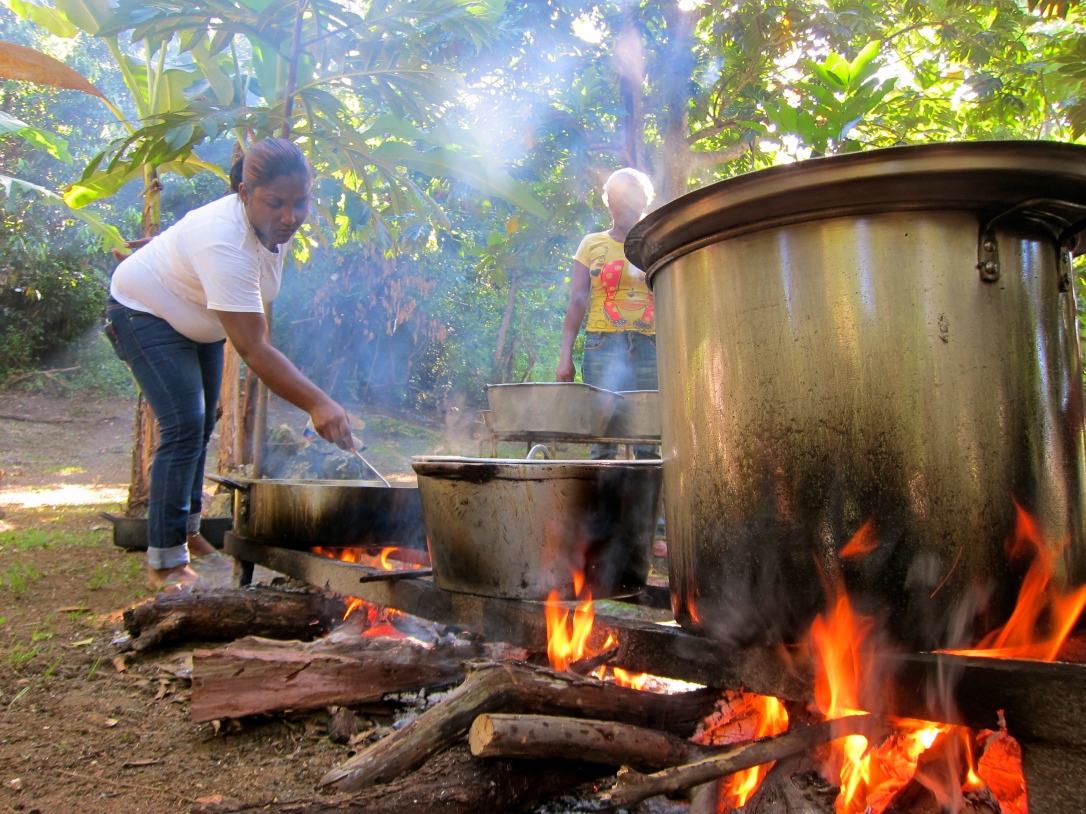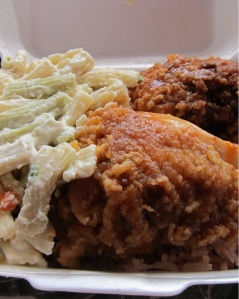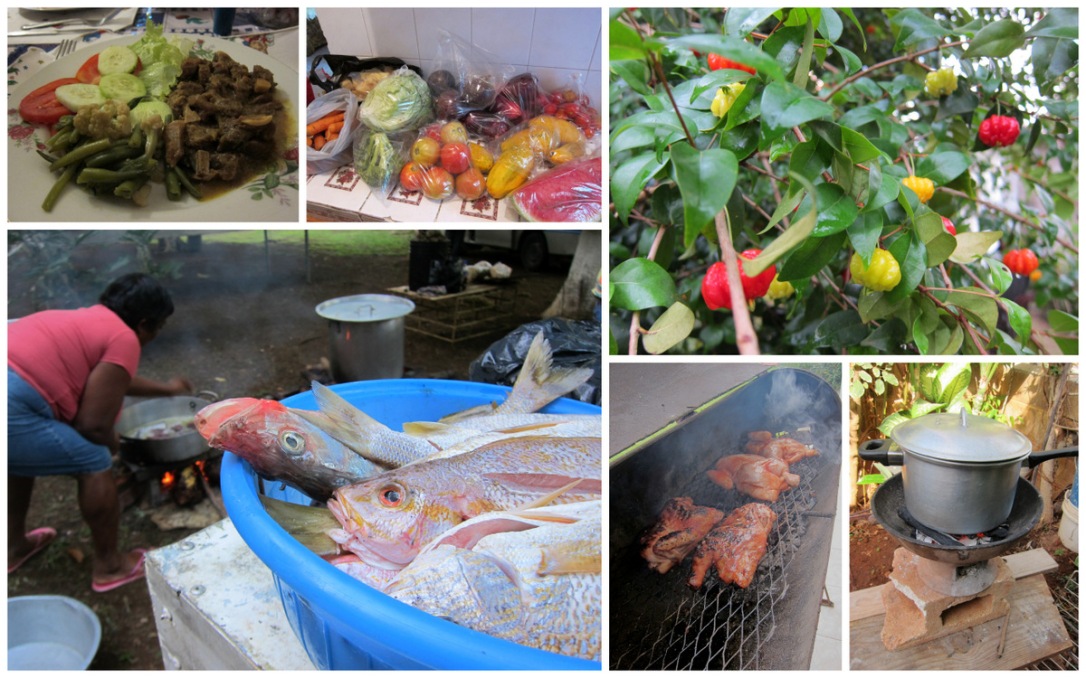A fellow volunteer recently asked me how come it took so long for me to write about food, since she knows of my extreme passion for cooking and eating. I just forgot. Food is one of those things both highly celebrated or simply a part of day to day life.
As a traveller, one of the best things about living abroad in another country is getting to try all the new food that the country you are visiting/living in has to offer. If you are a Sociology geek such as myself, you’ll also love the rich cultural and historical context that food provides when getting to know a country. If you love to cook, learning a couple of local favorites is a great tool for integrating and earning respect. If you are a Peace Corps volunteer, it’s also a great time to try different recipes and work on your cooking skills.
But in the end, for me, it’s all about eating. I love to eat.
Like many developing countries, Jamaican food is rich in tradition but more practically based upon what is accessible in terms of ingredients and equipment. In its most simplified form, Jamaican cooking can be summed up in 6 words: fresh, stewed, baked, steamed, fried, and jerked. The food nerd in me could talk for days about all of this but I’ll do my best to give you the most common themes.
Fresh
With a wide range of land and micro-climates to work in, ample sun, rain, and fertile lands, Jamaica is blessed to have a 365 day growing period. While many still get their produce from a local open air market or grocery store, Jamaicans also tend to grow a fair number of fruits in their yards both intentionally and unintentionally (fruit discarded after being eaten). People are also not afraid to eat what they’ve grown themselves, which is something we need to do more in the states. Most of the produce, especially the vegetables, are pretty familiar (though I would argue that the tastes are different. Ie. carrots and corn here don’t taste like carrot and corn I’ve had in the states). It’s the variety of different fruit that really impresses me. Many Jamaican families make their own natural juices and everyone has a particular kind of mango they prefer.

Though many of the produce is grown here on island, it’s important to note that Jamaica does import produce, like grapes, brussel sprouts, and apples. As with most things, best to buy and support local farmers.
Here’s a general run down of the produce you can find here.
Items Common to Us in the States – most items can be found year round unless otherwise noted
| Papaya | Bananas Different varieties |
Pineapple Different varieties |
Watermelon Different varieties |
| Cantaloupe | Onions | Potatoes | Tomatoes |
| Green Pepper | Carrots | Green Onion/Escallion | Yam |
| Sweet Potatoes | Pumpkin/Squash Less like pumpkin, more like squash. |
Pear/ aka. Avocado (s) Imagine supersized Mexican/Cali hass variety. So good. |
Mango (s) many varieties |
| Pap Chow/Bok Choi | Hot Peppers Mostly Scotch Bonnet but other varieties as well |
Cabbage | Corn more tough, not as sweet |
| Cho Cho/a chayote Super versatile vegetable and cheap. |
Cucumber | Eggplant | Zucchini |
| Lettuce | Apples (i) | Strawberries (i) | Cauliflower |
| Garlic (i) | Broccoli | Grapes (i) |
(s) – indicates seasonal
(i) – indicates imported items
Items Uncommon to Us in the States – Most of these items are seasonal unless otherwise noted
| Otaiti Apple (Jamaican Apple) Great for juice and eating. Typically cheap. Seasonal. |
Custard Apple Mushy texture but interesting flavor. |
Star Apple Great tasting but skin my cause allergic reaction |
Star Fruit Great for juice and eating |
| Passion Fruit Great for juice |
Guava Great for juice and marinades |
Jack Fruit Huge, strange looking fruit. Taste like bubble gum |
Plantain Like a giant banana. When fried ripe it’s sweet. When frying an un ripe one, it’s like a french fry/potato |
| Sour Sop Great for juice and eating |
Sweet Sop Great for juice and eating |
Cherries Not the kind you see in the states but used in the same way. |
Neesberries Like eating brown sugar. Some love it. |
| Ackee A fruit used in the national dish. Texture like scrambled eggs. Good cooked. |
Calaloo/Collard Greens (y) Many will say it’s like spinach. It’s not. It’s like collard greens. |
Breadfuit Roasted and friend makes this takes like fries. Great with stews. |
(y) – Found year round
A Literal Melting Pot
Jamaicans love to stew things. They love hot soups (even in hot weather). Part of me thinks this is tied to British culture leftover from colonial days. Stewing is also a great way to cook tough cuts of meat that are considered to be cheap and easily accessible. You’ll find that a lot of the meat sold in stores and at the market are chunks of meat, not the fancy cuts you find in butcheries in other developed countries. These chunks and parts of meat are slowly stewed over hours and the sauce made is often thickened to make a gravy. I’m talking about parts like cow feet, pig’s tail, chicken back, turkey neck, pork, chicken, and my beloved oxtail (all with bones included). Over rice, it’s one of my favorite things to eat. Anywhere.

The melting pot metaphor also refers to the mixing of different cultures and their influences on the country’s cuisine. One of the most popular things you’ll find in Jamaica is the use of curry. Curried chicken is ubiquitous in cookshops all over the island and curried goat/mutton is a holiday favorite and treat. The use of curry comes from the the Indian immigrants that came decades ago as indentured servants and sugar plantations workers after slavery was abolished.
Frying

Similar to stewing, frying is an important cooking method related to the the historical context of using what you have and what you have access to. Jamaicans fry a lot of things. They fry fish, breadfruit, plantains, roti (Indian flat bread), fritters, festival (fried bread), and my favorite, chicken. Frying is an easy cooking method and though unhealthy in some regards, frying is a way to make sure your food is fully cooked. This was important for Jamaicans who didn’t have access to fridges or freezers like they do now. Also, frying requires oil, fire, and a pot- things accessible to most families. Many still use gas or wood stoves for cooking. Electricity- and thus, electric stoves- were not common back in the days and so a culture of cooking around frying and stewing was cultivated. That’s not to say that baking doesn’t exist in Jamaica today, but it’s just not as common of a practice compared to stewing and frying.
—
These are just some oversimplified and generalized themes I noticed about Jamaican cooking in my short time here. There’s still a lot more things to eat and I haven’t even talked about Jerk and spices, mainly because it’s too hot for my personal taste (so I avoid it like I avoided talking about it). It’s been fun and tasty to learn about Jamaican cooking. I’ve enjoyed tasting, but more importantly learning how to cook local favorites that I’ll take home with me to share with family and friends on our return. I’ve enjoyed cooking so much that another volunteer and I started a blog to document our and our fellow volunteer’s food adventures in Jamaica – http://pcjcookshop.wordpress.com/
All this talk of food is making me hungry. Till next time.
-J








